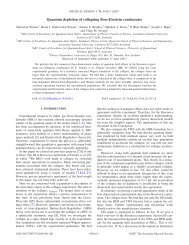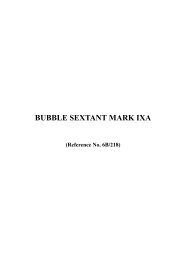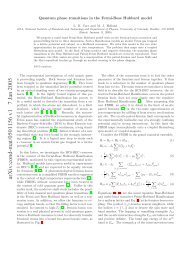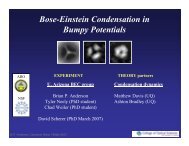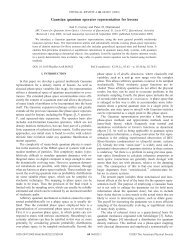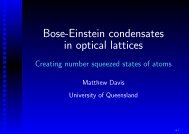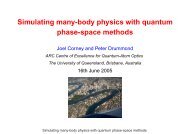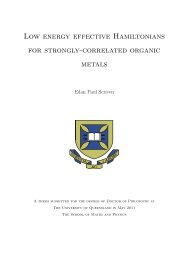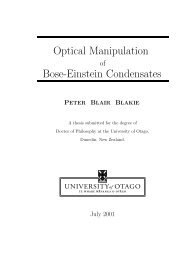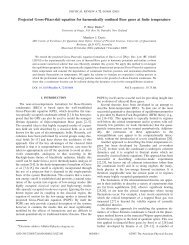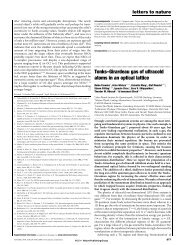Open Quantum Dynamics of Mesoscopic Bose-Einstein ... - Physics
Open Quantum Dynamics of Mesoscopic Bose-Einstein ... - Physics
Open Quantum Dynamics of Mesoscopic Bose-Einstein ... - Physics
Create successful ePaper yourself
Turn your PDF publications into a flip-book with our unique Google optimized e-Paper software.
1. Condensation ‘without forces’How is this quantum degeneracy induced? What conditions will force massive particlesinto the same state so that they become indistinguishable?The answer lies inHeisenberg’s uncertainty principle 6 , a fundamental principle underlying all <strong>of</strong> quantummechanics.This principle states that there is associated with all physical systems anirreducible uncertainty, such that there is a limit to the precision with which two complementaryquantities may both be known. For example, in terms <strong>of</strong> the uncertainty <strong>of</strong> theposition ∆x and momentum ∆p <strong>of</strong> a particle, the uncertainty principle states that∆p∆x ≥ 2 , (1.1)where is related to Planck’s constant by h =2π. Thus the more definite is a particle’smomentum, the more uncertain is its position. This gives rise to the wave nature<strong>of</strong> quantum mechanics, since a particle’s state is now probabilistic, encapsulated by awavefunction. The uncertainty in position is reflected in the spread <strong>of</strong> the wavefunction.For two particles to be in the same state, their wavefunctions must overlap and becomeindistinguishable. The spatial spread <strong>of</strong> the wavefunction is characterised by the de Brogliewavelength, which for particles in thermal equilibrium isλ th =h√ 3mkB T , (1.2)where k B is Boltzmann’s constant, m is the mass <strong>of</strong> the particles and T is the temperature<strong>of</strong> the gas. Thus particles with a smaller mass have a larger position spread, which is whyhydrogen was considered for many years to be the most promising candidate with whichto achieve condensation.<strong>Quantum</strong> degeneracy in a gas occurs when the de Broglie wavelength becomes largerthan the interparticle spacing. This gives a critical temperature T c for the onset <strong>of</strong> <strong>Bose</strong>-<strong>Einstein</strong> condensation which increases with density <strong>of</strong> the gas. Hence the gas must betightly confined while it is cooled so that a relatively high density is maintained. It is notthen surprising that the two main enemies <strong>of</strong> successful condensation are heating effectsand unwanted interactions between particles. Interparticle collisions may produce excessiveatom loss from traps as well as causing atoms to stick together. This is detrimentalas the atoms must remain delocalised to avoid forming into a solid.However, certain interactions, namely elastic collisions, are needed to mediate the energydistribution (thermalisation) described by <strong>Bose</strong>-<strong>Einstein</strong> statistics. The large effective6 Also introduced in 1927, a very important year for quantum mechanics!16



